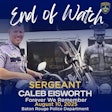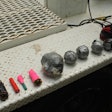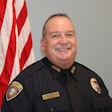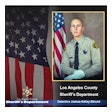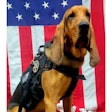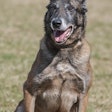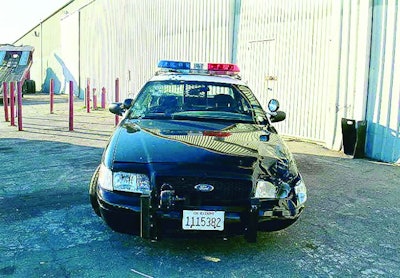 The damage to Officer Lavoie's patrol car offers vivid evidence of the ferocious firefight. Photo: Officer Lavoie.
The damage to Officer Lavoie's patrol car offers vivid evidence of the ferocious firefight. Photo: Officer Lavoie.
For Officer Kris Lavoie of the Ontario (Calif.) Police Department, Super Bowl Sunday 2002 would prove to be a busy one. But not in the way that most Americans enjoy. For Lavoie had no idea just how busy. Or just how much he would feel like a real "gladiator" before the day was over.
The vicinity of Holt Boulevard and Mountain Avenue in Ontario often proves to be ground zero for problems. This low-income area is a perennial destination for first-generation immigrants trying to start a new life. The neighborhood also plays host to the usual suspects running the same old scams: dope dealing, prostitution, and predatory vagrancy.
Standing out among such confines can be something of a challenge, but the driver of an older brown Oldsmobile was up to it. His jailhouse tats, wife-beater T-shirt, and beefy musculature screamed out "parolee," and Officer Lavoie on patrol in the area decided to check him out. He plugged the information into his patrol car's mobile data terminal. The Olds' license plate came back expired.
Lavoie decided to make a stop. But before he could catch up to the Olds, its driver, Tony Reyes Martinez, negotiated a series of sharp turns on nearby residential streets before suddenly pulling into a driveway, parking, exiting on foot, and heading into an adjacent apartment complex. Martinez's haphazard maneuvers suggested less an attempt to evade Lavoie than a determination to get on with a particular mission. Lavoie's curiosity as to what that mission might be led him to pull around a nearby corner where he parked and kept vigil as Martinez entered the complex on foot.
Lighting Them Up
When Martinez re-emerged five minutes later, he was in the company of another male Hispanic. The man was Carlos Omar Meza, a 23-year-old Happy Town gang member who'd earlier that day committed a shooting at the Indian Hill Swap Meet in nearby Pomona.
Lavoie didn't have that information. He just relied on his good cop instincts when he pulled in behind the Olds and followed the two men as they pulled into another apartment complex on the south side of the street and lit them up.
Seeing Lavoie's lights in the rearview mirror, the men in the Olds continued to cruise slowly down the driveway, looking right and left for God knew what before making a left turn at the rear of the apartment complex-then finding themselves boxed in.
The car's sudden stop obligated Lavoie to park at a 45-degree angle to the Olds, instead of directly behind it as he would have preferred. A mere half car length separated the driver from Lavoie, but it was the passenger, Meza, who turned and stared at the officer.
Despite the broad daylight, Lavoie turned the spotlights on the men. The hairs on the back of his neck stood up, telling him there was something wrong. Seeing the passenger start to get out of the car, Lavoie hastened his own exit from his patrol unit. He stood behind the driver's side door and ordered Meza back into the car.[PAGEBREAK]
 Three 12-gauge bursts struck the passenger side of Officer Lavoie's cruiser. Photo: Officer Lavoie.
Three 12-gauge bursts struck the passenger side of Officer Lavoie's cruiser. Photo: Officer Lavoie.
Martinez didn't get out of the car, but Lavoie could see that the man was in the driver's door opening, bent over. He looked at Lavoie over his shoulder and then turned his attention back to the car. Calculated or not, Martinez's actions made Lavoie consider the possibility that the man didn't speak English.
Lavoie tried using his limited Spanish but got nowhere—the man continued to fixate on something beneath the Olds driver's seat. Lavoie removed his SIG 220 from its holster and broadcast over the radio that he had one at gunpoint to get the troops coming.
Martinez's lack of compliance and neither-here-nor-there posture in the car's doorway suggested to Lavoie that the man was fidgeting with some unseen weapon. Meanwhile, through the rear window of the car Lavoie saw a quick flash of what appeared to be a handgun. A split second of cognitive dissonance kicked in: There was no way I just saw a gun.
Then Meza rose up and out of the passenger side door with a shotgun.
Taking Fire
Lavoie immediately fired a volley of two rounds through the back window of the car, through the passenger-side headrest. Meza started to fall backward, causing the barrel of the shotgun to elevate. Squeezing off a third round, Lavoie moved to the back of his car for cover, dropping to one knee behind its trunk. Meza rose up, firing four rounds from the shotgun and shattering Lavoie's lightbar and windshield.
Meza's barrage of gunfire continued; Lavoie's mind kicked into hyperdrive. His SIG had seven-plus-one capacity, and he carried two extra magazines. On bent knee, Lavoie opted for a tactical reload near the trunk of the car. When the second magazine locked into the gun's well, quiet fell upon the scene and Lavoie thought that maybe his rounds had found their mark and the suspect was down.
But when Lavoie peered back over the roof of his patrol car, the sight shocked him. Meza was not down but on the move, bearing down on Lavoie with the shotgun as he made his way around the Olds to the rear passenger door of the officer's unit. Lavoie started pumping shots through the back window of his car, but the .45 rounds didn't penetrate through the interior cage and the rear glass.
The Olds' driver was backing the car to give the shooter cover. Officer and suspect momentarily backpedaled from one another. Meza went for the cover of the Olds as Lavoie went for a truck parked in the carport behind his car. Lavoie fired four rounds of suppressive fire to cover his move.
The shotgun-wielding passenger might have been the more obvious threat, but Lavoie hadn't forgotten about the driver and the possibility that the two men might try to triangulate on him. The thought of each suspect coming up on him from different angles weighed on his mind.
Moving behind the pickup, Lavoie conducted a quick peek over the bed then retracted his head tortoise-like just as another shotgun blast peppered the truck. Lavoie moved behind the tailgate and fired another round in Meza's direction, forcing the man to duck down.
Lavoie started to reload, but was interrupted when Meza suddenly emerged around the back corner of the truck, pointed his gun at Lavoie, and squeezed the trigger.[PAGEBREAK]
 The suspects' car was battered by numerous shots from Officer Lavoie. Photo: Officer Lavoie.
The suspects' car was battered by numerous shots from Officer Lavoie. Photo: Officer Lavoie.
magazine.
Looking for Backup
Lavoie knew he needed to get out of the carport. He ran around to the front of the truck, worried that he would run into the second suspect at any moment. What he didn't know at the time was the man was hit and down in his car. Without a driver, the Olds had drifted into a fence.
Lavoie looked for another place to go. Behind him was a chest-high block wall with barbed wire on top of it. He didn't want to get penned in with no ammunition, so lacking any other available cover and not wanting to go up against these guys with only a knife, he ran into the alley as much in a bid to get some distance between himself and the suspect as to look for his backup.
Lavoie was so focused on getting back to the driveway access to the street that it was only later that he would learn the suspect actually chased after him. Fortunately, the first person he saw was fellow officer Cpl. Doug Reed pulling up to the scene.
Meza jumped into Lavoie's unit. So tight were things in the parking area that he had to smash forward and backward into cars and walls in a desperate bid to flee the scene. After four or five such maneuvers, he succeeded in bounding past Reed's patrol car and onto the street, but not before Reed was able to get off a few rounds.
Reed remained with Lavoie and accompanied him back to the original crime scene to check out the suspect car and the status of its driver. That was when they found Martinez lying down in the front of the car where he'd taken a head shot.
Drop the Weapon!
As numerous officers converged on the vicinity, Meza sped northbound against southbound traffic on Mountain Avenue. The windows were shot out of the patrol car and the spotlights and steady red light were on, so responding units initially didn't know what was going on. Some thought Lavoie was in pursuit; others surmised that Lavoie was driving himself to the hospital because he'd been shot. A number of Ontario PD units fell in behind Lavoie's unit, not knowing the bad guy was driving the car.
By the time Reed got on the radio to clarify the situation, Meza had turned onto 4th Street, a couple of miles away, where he lost control and hit a parked semi-truck before he exited the car, shotgun in tow.
Officers chased Meza down the street.[PAGEBREAK]
 Suspect Meza used this shotgun in the assault on Ontario PD officers. Photo: Officer Lavoie.
Suspect Meza used this shotgun in the assault on Ontario PD officers. Photo: Officer Lavoie.
Langford sprinted to the sidewalk to cover the south and east sides of the containment area. The vantage point gave him excellent views of the suspect's possible escape routes, but little in the way of cover or concealment.
Radio reports told Langford the suspect was pinned down in the alley. Langford peeked around the corner as an aero unit reported that the suspect was hunkered down behind a dumpster. The aero unit advised that the suspect had reloaded his shotgun and was waiting for officers to run around the corner.
The officers hung back prudently. At which point Meza held the shotgun overhead as though to signal surrender. But when officers issued commands for Meza's compliance, he instead pointed the weapon in their direction before running off through the apartment courtyard.
Meza's mad dash put him on a collision course with Langford, who saw the man darting along in a military-style crouch with the shotgun at low ready. Twice, Langford yelled at the suspect to drop the weapon.
Instead, Meza started to raise the shotgun toward Langford. Langford opened fire. Meza jumped onto an apartment porch, taking cover behind a low wall where he raised his shotgun through the opening to the porch. To compensate, Langford moved to his right and took cover behind a porch wall on the opposite side of the courtyard. Bordered on both sides by hedges, the only way Langford could see the suspect would be to raise his head over the wall.
Rather than wait for the suspect to get a jump on him, Langford decided to take the fight to the suspect. It was a timely decision. For as Langford jumped out from behind the wall he found that Meza had already closed half the distance between them, committing himself to "no man's land." Only 15 feet separated the two; Langford fired his remaining two shotgun rounds. The first blast spun the suspect to his left, the second to his right-and still Meza advanced on Langford.
Transitioning to his SIG duty weapon, Langford focused on his front sights to ensure that he was on target, then squeezed off six rounds. Meza's momentum carried his body forward until he finally collapsed at Langford's feet. Handcuffed, Meza was transported to a local hospital where he was pronounced dead.
Aftermath and Honors
The Ontario Police Department has changed several procedures as a result of this shooting. Lavoie had trouble receiving calls from dispatch during the incident due to the way he holstered his handheld radio on his belt. The department has since adopted microphones attached to the uniform. Officers have also started to carry slugs in their shotguns-four rounds in the tube and one in the chamber, and carry eight additional rounds. Shotguns are also equipped with additional tactical equipment.
Looking back, Lavoie feels pretty comfortable with his performance that day, and he believes that his conscientious attitude when it came to training paid off. "But then," he notes. "I've always felt that if you practiced like crap, you perform like crap."
Still, he wishes that he had considered looking beneath the vehicles for the suspect during the point that he momentarily believed the suspect to be down. He might've been able to take the suspect out at the ankles.
For their heroic actions that Super Bowl Sunday, Lavoie and Langford each received numerous awards and citations, including the Ontario PD Medal of Valor. Both continue to serve the citizens of Ontario.










